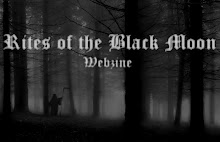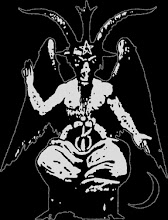
Satyricon started as a Death Metal band. Neither Satyr nor Frost are original members of the band, as they more or less inherited it and opted for the Norwegian Black Metal sound, as many bands did around this time. The lyrics are dark, but not actually Satanic. Satyr once claimed that their style was 'Medieval Metal', for whatever that is worth. Satyricon is one of the last bands to emerge from the Norwegian scene, around this time, and it is clear that, despite creating decent music, they were simple followers of those that came before them. This is more of an instance of people being in the right place at the right time (as can be seen by the fact that they got bored with this style within a couple years and moved on to something else).
Dark Medieval Times was recorded in the Ancient Spectre Ruins, in the late summer months of 1993, and is the first album to be released on Moonfog Productions. The lineup consists only of Satyr (on vocals, guitars and keyboards) and Frost (on drums). The cover artwork, by Jannicke Wiese-Hansen, is very pleasing to the eye and well-suited to the music, while also being similar to that found on the early Burzum albums (of course, with the same artist).
"Walk the Path of Sorrow" opens the album with strange keyboard effects, imbuing the listener with the sense of an upcoming battle. This really does well to create a medieval atmosphere and, despite the obvious influences shown by this band, they did take an original approach to it as well. Once the music really begins, the first thing that comes to mind is Burzum. One must wonder how far the Ancient Spectre Ruins are from Grieghallen, as this doesn't sound far removed. Even the unrestrained vocal approach seems similar to what Varg has done. There is a lot of acoustic guitar use, giving kind of a mystical feeling to the song. There are several tempo changes, as this doesn't remain the same for very long at all. About mid-way through, the song speeds up, with blasting drums and tremolo riffs, though the riffs aren't actually anything special. The atmosphere is being created by the keyboards, more than anything, which takes away from the music. That is, probably, my greatest problem with this band; if you strip away the keyboards, you are left with mediocre riffs far too often. The melodies are actually pretty good and could, easily, have been played on the guitar instead of relying on the synth. But none of this is meant to say that this isn't a good song.
The next song is "Dark Medieval Times", maintaining the ethereal atmosphere from the previous song. This is an epic composition, possessing a dark and eerie atmosphere. The guitars are cold and harsh. The vocals, while sounding very inspired by Varg, have a lot of feeling and suit the music just fine. There are silent sections, with only acoustic guitars, whispered vocals and the sound of freezing winds blowing. This is followed by very intense drumming and frenzied guitar riffs that actually just serve as an interlude before the acoustic guitar returns, now accompanied by a flute. What comes after is another riff that sounds like it belongs on Hvis Lyset Tar Oss.
"Skyggedans" is fairly mid-paced. Satyr's vocals sound closer to those of Nocturno Culto, on this song, while some of the riffs are not so different from In the Nightside Eclipse, but the use of acoustic guitars and the medieval atmosphere is purely Satyricon. The song never speeds up beyond a simple gallop, and the keyboard use is pretty minimal. Again, some of these riffs really do sound very similar to Burzum.
"Min Hyllest Til Vinterland" opens with the sound of wind and acoustic guitars, making for a very calm and almost serene feeling. One might even be reminded of certain passages from Viking-era Bathory. The song gives the feeling of riding through the dark woods, late at night, during the winter.
The calm feeling established on the previous track continues during the opening moments of "Into the Mighty Forest", yet this song does erupt with freezing cold fury, utilizing fast tremolo strumming and blast beats. Satyricon never keeps the same pace for too long, as this slows down and becomes more mid-paced. Satyr's throat sounds shredded, which goes well with the dark atmosphere created on this song. The only complaint would be the use of keyboards. On this particular song, they seem to realize that keyboards are meant to accentuate the atmosphere, not to be the sole source of it. However, one could argue that this really didn't need anything extra, as it is one of the best composed songs on the whole album.
"The Dark Castle in the Deep Forest" begins with another tortured scream. The vocals seem to be kind of low on this song, with a doomy synth line overpowering most of the instruments, in the early moments. There is a break, leaving only the eerie synth, before the guitars return. The winter landscape is in the embrace of morbid shadows. The atmosphere becomes more sinister as the song progresses. Even in the faster riffs, the medieval melodies are present, rather than just being found in the acoustic sections. One can feel the desolation of this ruined castle, far beyond all human realms, in the deepest forest. Over the course of the song, you are dragged from the murky forest and taken deeper into the castle, finally chained and tortured in the dungeon below.
The album ends with "Taakeslottet". This song begins with a desperate scream, tremolo riffs and double bass, yet quickly slows down to an atmospheric crawl. The vocals are whispered, at first, adding to the haunting feeling.
The criticism aimed at this album is not meant to imply that it is bad, by any means. It is simply my opinion that it could have been even better, at certain points, especially regarding the keyboard use. What Satyricon has done here is something original, within the framework laid down by their primary inspirations. Whereas with the earlier Norwegian bands you hear their 80s influences, this sounds very much inspired by those bands of the early 90s Black Metal scene in Norway; the prime example being Burzum, though there are small traces of Darkthrone, Mayhem and even Emperor to be found here. This is not to say that Dark Medieval Times is completely derivative of these bands; Satyr and Frost have taken this and added their own unique vision to it to establish a sound all their own. Satyricon was only ever a second-tier band, at best, and has since dropped into creative obscurity. Nonetheless, their debut L.P. remains a worthwhile listen.
.jpg)


